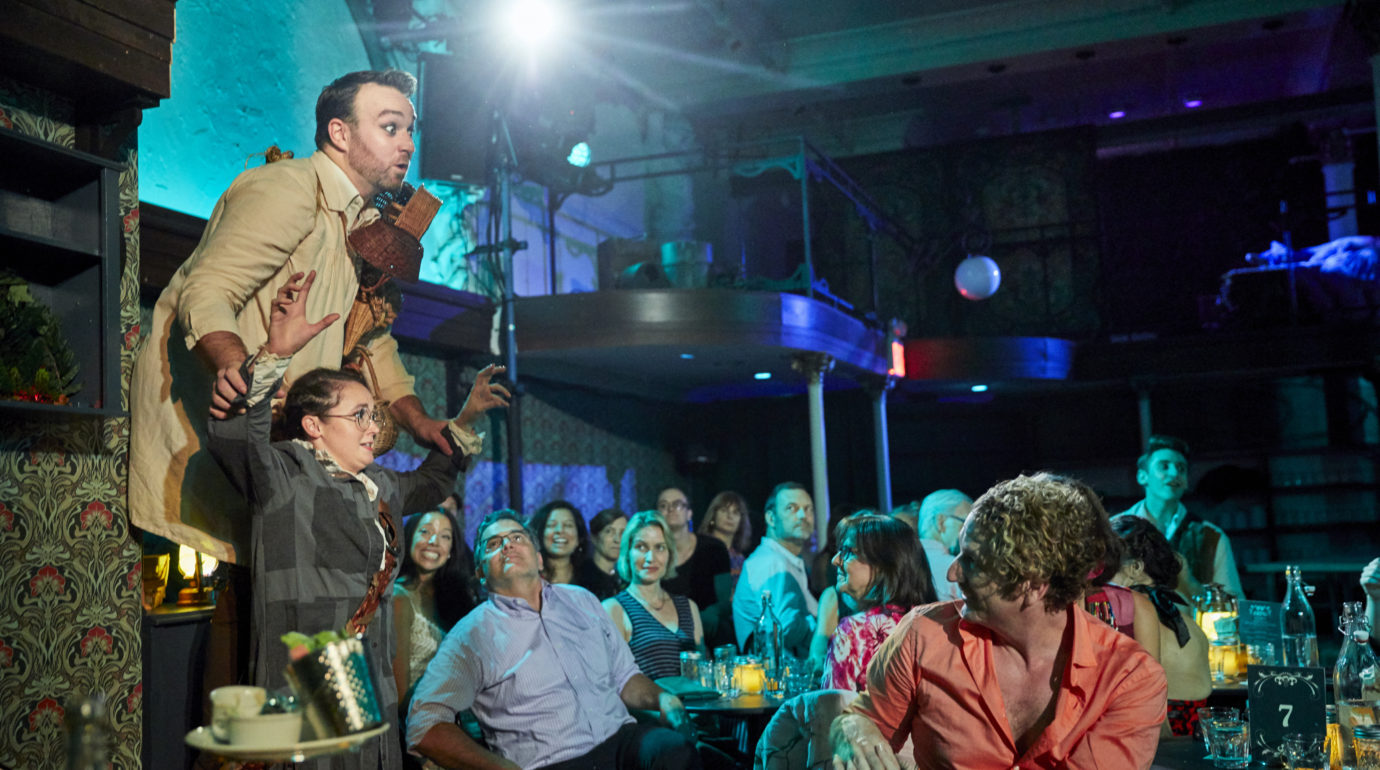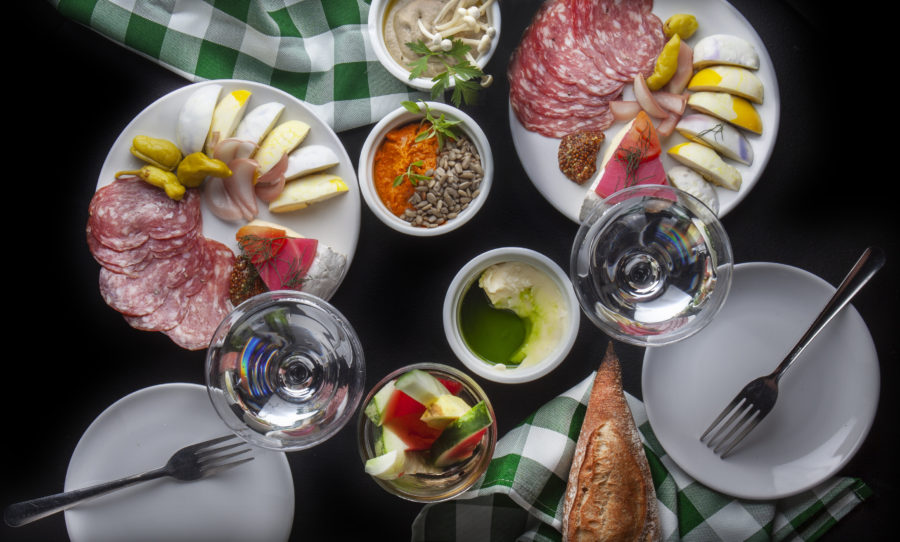In an increasingly digitized world, immersive theatre has flourished by using tactile experiences to stimulate all the senses. In recent years, more and more productions have begun to serve thematically linked drinks and bites at crucial narrative moments to establish a time and place and a deeper connection to the story.
Weaving food and drink into storytelling isn’t a new trend: Natasha, Pierre and the Great Comet of 1812 served its guests a full Russian-themed meal during its Off-Broadway iteration; Sweeney Todd at Barrow Street Theater served actual meat pies; and most recently, Network on Broadway allowed select audience members to dine onstage with the cast.
Third Rail Projects, known for its pioneering brand of site-specific theatre, has now put its unique spin on the concept of dinner and a show with the new production of Midsummer: A Banquet, running through Sept. 7 at a custom space in near Union Square in New York City. It’s a take on Shakespeare’s hedonistic classic that comes with a three-course food and wine pairing.
Third Rail co-artistic director Zach Morris, who serves as the production’s director and choreographer, first became interested in a collaboration with Food of Love, a company which specializes in mixing dinner and Shakespeare. To him, A Midsummer Night’s Dream was a natural story to pair with food. “The plot itself is about these people becoming consumed with this sort of ravenousness towards each other,” Morris explains. “So the metaphor of desiring or being hungry for, or eating or drinking each other up, became a really fun way into the show.”
Morris worked in tandem with designer Emilie Baltz to create the savory and sweet pairings with the action. With degrees in screenwriting, modern dance, and industrial design, Baltz discovered the unique storytelling capabilities of food while working on brand design and creative direction for restaurants such as Dovetail, Room4Dessert, and the bars at the Museum of Sex.
“The unique thing about food as a material for design is that it’s our only multisensory material in the world,” says Baltz, who has built a career out of creating themed menus for live events and is the founder of the Food Design Studio at Pratt Institute. “When you eat you don’t just eat with your eyes, you also eat with your ears, with the smell, with the texture—all those different sensory prompts also affect your perception of what you’re tasting.”
The show opens as audience members step into Cafe Fae, an empty storefront (once the home and studio of the painter Willem de Kooning), converted into a Parisian-style cafe. Once the location was secured in early 2019, the creation of Cafe Fae, including the stage, restaurant floor, and a small kitchen, took just under three weeks, led by production manager Brittany Crowell.
The spatial and budgetary constraints created challenges: The four chefs and two dishwashers can only work a certain amount of hours, and can’t make much noise as they work. So ingredients must arrive pre-cooked, to be assembled into 130-plus servings per course on-site. Dishes also have to be substantial, organic, and suitable for vegan and gluten-free diets, while also being budget-friendly. The actors also doubled as waiters.
The first course is prepped and ready before the show begins. Audiences are seated at classic bistro tables preset with a selection of aperitivi and tapas: crudites, salumi, cheese, vegetables, and breads.
“The play quite literally begins with a couple, Theseus and Hippolyta, who are about to be married, and we wanted to ease the audience into the play by creating this liminal threshold, which is the café,” says Morris. “So as the audience enters, we wanted to have a spread that is perhaps similar to what one might find at a rehearsal dinner for a wedding.”
The familiar restaurant setting transforms gradually into the dream-like atmosphere of the play with the help of the second course—what the show calls ‘‘faerie kebabs”: roasted olives, apricots, and mushrooms on toothpick skewers, served in sealed mason jars.
“Every ingredient is either directly referenced in the text itself, like apricots, mushrooms come from the forest, olives come from the Mediterranean region and Athens,” explains Morris. “We wanted to create that sort of palate as you move into a forest space.”
For Baltz, that dish presents the show’s most difficult technical challenge. “Seconds before they come out there’s a fleet of four chefs who are intensely using a smoking gun, using fresh applewood and pumping smoke into jars, just so that the audience can have that olfactory experience. When you open it up you get a little puff of smoke. And then the room also starts to transform and smell like apricots or applewood smoke.”
The next and last savory offering comes at the moment when Titania falls in love with Bottom. “She feeds him this sort of grain bowl which is inspired by the things he talks about later on in the show: He wants a handful of oats, he wants grains, he wants a handful of dried peas,” explains Morris.
The choice of a miso bowl vessel and spoon utensil also serves a practical purpose. “A spoon makes less sound in the room,” says Baltz.
Near the top of Act Two, audience members are tossed bundles of fresh and seasonal farmer’s market fruit such as cherries or peaches to share at a moment where the lovers come together.
“You have these love bundles full of seasonal fruit that you’re eating with your hands and juices dripping down your face,” says Morris. “It is a very sensual experience in the same way that the lovers are navigating their passion.”
Later on audiences participate in a champagne wedding toast alongside the characters. As the show ends, a selection of petits fours-inspired sweets on sticks are brought out on wooden trays painted to resemble tree trunks, to whisk patrons back to reality after their experience at Cafe Fae.
“We wanted to put them around the room so people can stand up and mingle with each other,” said Morris. “Especially in this cultural moment, finding moments where we can engage with other human beings to share an experience with strangers, where we’re able to break bread together, feels so important.”
For Baltz, the future of immersive and experiential theatre will naturally intersect with fine dining, as restaurants have taken cues from the theatre to involve elements of storytelling. “El Bulli basically made theatre in a restaurant,” Baltz says, referring to the provocative and experimental deconstructions the Michelin-starred gastronomic laboratory in Spain. “They turned on their head what food could be. Suddenly you’re eating ideas, and being able to have conversations that were also intellectual as much as they were visceral.”
At a time when higher labor costs and increasing rent challenge both the restaurant and theatre industries in New York, this new trend has the potential to reinvigorate both. “The language and process used in theatre and in restaurants are really similar,” says Baltz. “We’re both hyper-concerned with guest experience. Hospitality takes the same premise as experimental design does. There’s a lot of commonalities that can really help drive the bottom line and hopefully transform the profitability of this marketplace, and also be able to pay the amazing creatives who make this brilliant art.”
Jessica J. Wu is a food and culture writer originally from Queens, N.Y.







